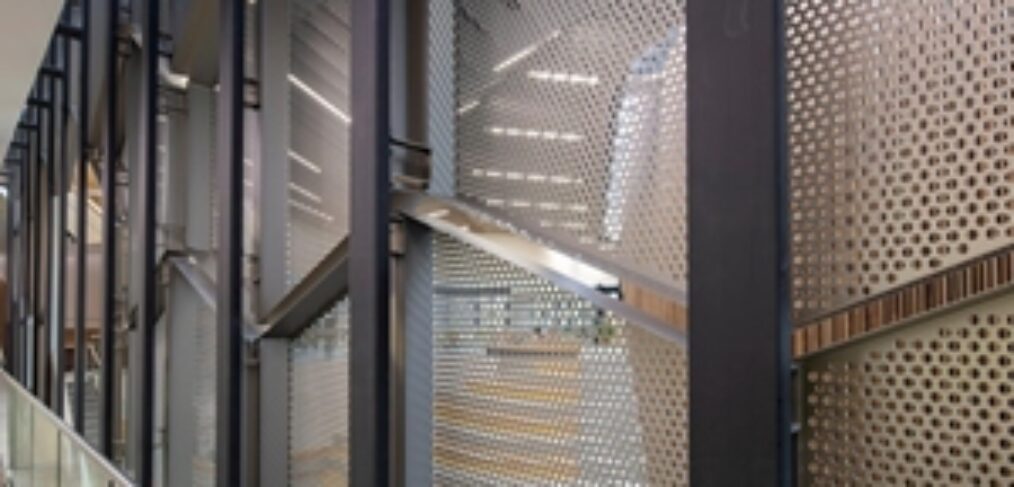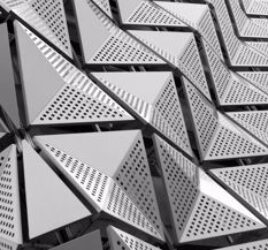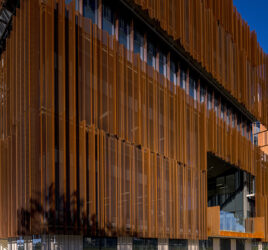
The main differences between galvanised steel and stainless steel
Whether you’re talking about the structural or aesthetic elements of buildings, steel is one of the most important innovations in the modern world. Stronger and more resistant to various forms of degradation than iron, steel has served as the catalyst for everything from the bones of high-rise buildings to unique and eye-catching design components.
Understanding the differences between the various types of steel available can help you make the most informed and positive choices possible. Let’s go through a quick review of exactly what steel is, to help set the stage for identifying the differences between galvanised steel and stainless steel.
 Galvanised steel is common in a variety of construction applications.
Galvanised steel is common in a variety of construction applications.Forging an understanding of steel
“Steel is an alloy made of two key base components: iron and carbon.”
Steel is an alloy made of two key base components: iron and carbon. An alloy is simply a combination of two or more types of base metals, or a base metal and an element. Alloys can provide a variety of important benefits in many different applications, from improving rust resistance to making non-sparking tools.
Specifically, steel has a number of advantages in the world of construction as compared to other potential building materials. It is:
- Durable
- Strong
- Easily recycled
- Of a predictably high quality when forged and finished in the proper manner
With many functional and aesthetic applications, steel is dependable and versatile. Regular steel can be further improved in a variety of processes, including the two detailed below.
What are the main differences between galvanised and stainless steel?
Galvanised steel
“Galvanised steel’s defining attribute is its layer of zinc coating.”
Galvanised steel’s defining attribute is its layer of zinc coating, which forms a protective layer against the combination of moisture and oxygen that can otherwise cause rust to form on the underlying metal. Rust slowly but surely eats away at steel, reducing its integrity and ultimately creating safety issues whether the steel is used in a purely functional application or is part of an impressive, customised facade or other design element.
Galvanisation takes regular steel or another metal, like iron, and adds a zinc coating. This process, which can be completed in a few different ways, helps increase versatility and allows for many different types of steel and iron to be easily galvanised. The hot-dipping galvanisation process provides a strong, relatively thick coating for large pieces of steel using molten zinc. Thermal diffusion galvanising, meanwhile, is common for smaller pieces of metal, especially those that have a more complex design. Both hot dip galvanisation and thermal diffusion galvanising have powerful applications.
In general, galvanised steel is less expensive than stainless steel. It is also easier to manipulate while still retaining a great deal of strength, but isn’t as strong as stainless steel.
One of the most visually memorable elements of galvanised steel is its variable appearance. Depending on the specifics of the process, galvanised steel can either have a consistent finish or a spangled one, creating a unique appearance.
While the galvanisation process helps protect against rust and provides corrosion resistance, it’s important to note that it eventually wears away, particularly when exposed to high levels of acidity or to salt water. This is especially important near oceans and other bodies of seawater, as well as areas that face significant exposure to acid rain.
Stainless steel
“Stainless steel has built-in defences against rust and corrosion.”
Stainless steel is an alloy made of iron, carbon and chromium and occasionally other elements, such as molybdenum, that offer significant corrosion resistance. Instead of being dipped or coated in a protective layer, as galvanised steel is, stainless steel has this defence against damage built into it.
There are many different types of stainless steel available, each with different compositions and resultant resistance to various forms of corrosion and damage. This is useful for industrial applications where stainless steel components may face constant exposures to caustic chemicals or high temperatures, as well as in design work where the alloy could be consistently exposed to salt water or acidic environments.
The manufacturing process makes stainless steel a more expensive choice than galvanised steel. However, stainless steel is generally stronger than its galvanised counterpart.
Stainless steel can also be finished in many different ways, providing a high degree of customisability in terms of its final appearance. This aesthetic flexibility is especially important for facades and similar design elements that place a high priority on standing out from the crowd by offering a memorable or unique visual hook.
Is stainless steel compatible with galvanised steel?
In the sense that these two types of steel can hypothetically be used for components of a single structure, yes. Stainless steel has some form of compatibility with galvanised steel. However, direct contact between these metals can lead to advanced corrosion if the right conditions are met, such as high levels of salt and moisture. In these situations, a non-metal material should be used to avoid the two types of steel making contact.
Which type of steel should you choose for your project?
There isn’t a single, universally applicable rule that determines which type of steel is best suited for your specific project. Understanding the differences between galvanised and stainless steel can go a long way toward helping you make this important decision.
Galvanised steel offers a unique patina from the finishing process and can capably perform in many environments for decades before appreciable rust or wear appears. However, stainless steel doesn’t face the same specific weaknesses caused by salt water and acidic environments, and some varieties of this alloy can be engineered in a way that addresses those concerns. In combination with the many ways in which stainless steel can be finished, there are plenty of aesthetic and practical concerns addressed by this alloy.
To learn more about the many ways stainless steel can be deployed in your next project, get in touch with the experts at Locker today.



